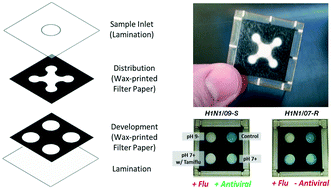Development of a point-of-care diagnostic for influenza detection with antiviral treatment effectiveness indication†
Abstract
Currently, diagnosis of influenza is performed either through tedious polymerase chain reaction (PCR) or through rapid antigen detection assays. The rapid antigen detection assays available today are highly specific but not very sensitive, and most importantly, lack the ability to show if the strain of influenza detected is susceptible to antiviral agents, such as Tamiflu and Relenza. The ability to rapidly determine if a patient has an infectious disease and what type of treatment the infection will respond to, would significantly reduce the treatment decision time, shorten the impact of symptoms, and minimize transfer to others. In this study, a novel, point-of-care style μPAD (microfluidic paper-based diagnostic) for influenza has been developed with the ability to determine antiviral susceptibility of the strain for treatment decision. The assay exploits the enzymatic activity of surface proteins present on all influenza strains, and potential false positive responses can be mitigated. A sample can be added to the device, distributed to 4 different reagent zones, and development of the enzymatic substrate under different buffer conditions takes place on bottom of the device. Analysis can be performed by eye or through a colorimetric image analysis smartphone application.

- This article is part of the themed collection: Coronavirus articles - free to access collection


 Please wait while we load your content...
Please wait while we load your content...